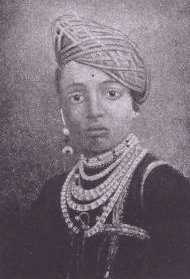Shivaji VI facts for kids
Shivaji VI (born April 5, 1863 – died December 25, 1883) was a young king, or Raja, of Kolhapur in India. He belonged to the Bhonsle family. He became Raja when he was only eight years old, in 1871, and ruled until 1883.
Shivaji VI was not born into the direct royal family line. His birth name was Shrimant Narayanrao Dinkarrao Bhonsle. He was adopted by the queen of the previous Raja, Rajaram II, when he was eight. Because he was so young, a special helper called a Regent ruled for him until he was old enough.
He received special honors during his rule. In 1875, he was given a sword of honor by Edward VII, who would later become a king in England. On New Year's Day in 1877, when he was just 13, he became a knight. This was a very special title called Knight Commander of the Order of the Star of India (KCSI). He was the youngest person ever to receive this honor. Later that same year, he also received the Empress of India Medal.
Contents
The Kolhapur Controversy
Around 1882, British officials in India said that Sir Shivaji VI was mentally ill. They placed him under the care of the British government. A new regent, Karbhari Mahadeo Barve, was chosen to rule Kolhapur in his place.
This decision caused a big argument. British officials and doctors insisted that Shivaji VI had an illness that could not be cured. English newspapers like the Times of India and the Bombay Gazette supported this official story.
Indian Newspapers Disagree
However, some Indian newspapers strongly disagreed. Papers like Induprakash, Mahratta, and Kesari questioned the British claims. Mahratta and Kesari were started by Bal Gangadhar Tilak, an important leader in India's fight for freedom.
Kesari openly questioned if Shivaji VI was truly ill. They also questioned how he was being treated. Kesari and Mahratta argued that Shivaji VI was not insane. They believed any problems with his mind were caused by bad treatment from the people who were supposed to care for him.
They especially accused Mahadeo Barve, the British-appointed regent, of being part of a plan to make Shivaji VI seem insane. Letters published in Kesari and Mahratta suggested that Barve and some British officials and servants were plotting against Shivaji VI.
The Court Case
To clear his name, Mahadeo Barve sued Tilak and the editor of Kesari, Agarkar, for saying false things about him. The court case that followed revealed many details about Shivaji VI's private life. It also showed how British officials had treated him poorly.
Kesari published everything that happened in the High Court trial. The newspaper believed this showed how unfairly the British officers treated Shivaji VI. On July 16, 1882, the court found Tilak and Agarkar guilty. They were sent to Dongri jail in Bombay for four months.
Even during the trial, Kesari wrote articles questioning why British officers had so much control over Shivaji VI. They worried that Shivaji VI's life was in danger from the very officers meant to protect him. Despite these serious accusations, the British government did not remove Shivaji VI from their care.
His Death and What Happened Next
Shivaji VI died young in 1883. This whole event became known as the Kolhapur Affair.
He was moved to Ahmednagar and died there on December 25, 1883, at the age of 20. He died after a fight or beating from a British soldier named Private Lloyd Passingham, who was supposed to be looking after him. Since Shivaji VI had no children, Shahu became the next Raja.
Many people in India felt that the way Shivaji VI died proved the accusations made by the Indian newspapers were true. Even though the court had ruled against them, this event was very important for the growing Indian Independence Movement.
Titles He Held
- 1863–1871: Shrimant Narayanrao Dinkarrao Bhonsle (His birth name)
- 1871–1877: His Highness Shrimant Rajashri Shivaji VI Chhatrapati Maharaj Sahib Rao Bahadur, Raja of Kolhapur (His title as Raja)
- 1877–1883: His Highness Shrimant Rajashri Sir Shivaji VI Chhatrapati Maharaj Sahib Bahadur, Raja of Kolhapur, KCSI (His title after becoming a Knight)


